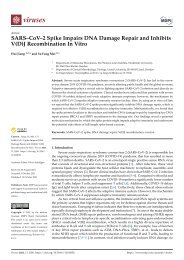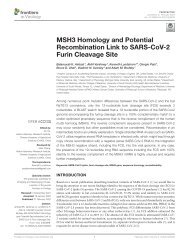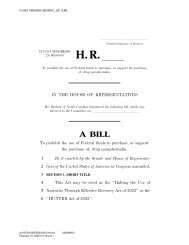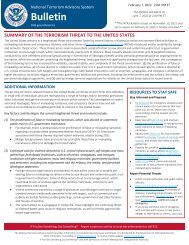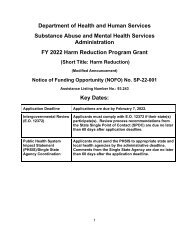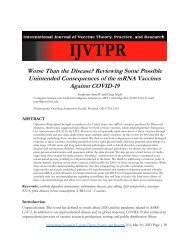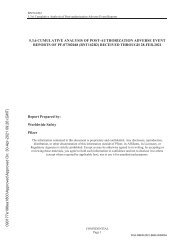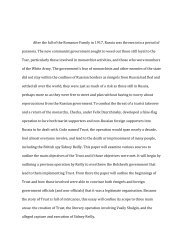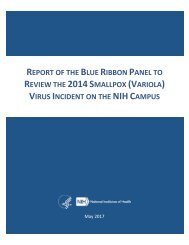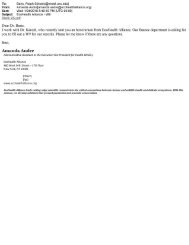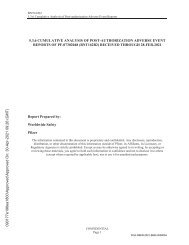A Literature Review and Meta Analysis of the Effects of Lockdowns on COVID 19 Mortality
Create successful ePaper yourself
Turn your PDF publications into a flip-book with our unique Google optimized e-Paper software.
al. (2020), found, based <strong>on</strong> questi<strong>on</strong>naire data collected from mid-March to mid-April, 2020, that<br />
even though <str<strong>on</strong>g>the</str<strong>on</strong>g> daily <strong>COVID</strong>-<strong>19</strong> mortality rate was more than four times higher in Sweden than<br />
in Norway, Swedes were less likely than Norwegians to not meet with friends (55% vs. 87%),<br />
avoid public transportati<strong>on</strong> (72% vs. 82%), <str<strong>on</strong>g>and</str<strong>on</strong>g> stay home during spare time (71% vs. 87%).<br />
That is, despite a more severe p<str<strong>on</strong>g>and</str<strong>on</strong>g>emic, Swedes were less affected in <str<strong>on</strong>g>the</str<strong>on</strong>g>ir daily activities (legal<br />
in both countries) than Norwegians.<br />
Many o<str<strong>on</strong>g>the</str<strong>on</strong>g>r factors may be relevant, <str<strong>on</strong>g>and</str<strong>on</strong>g> we should not underestimate <str<strong>on</strong>g>the</str<strong>on</strong>g> importance <str<strong>on</strong>g>of</str<strong>on</strong>g><br />
coincidences. An interesting example illustrating this point is found in Arnars<strong>on</strong> (2021) <str<strong>on</strong>g>and</str<strong>on</strong>g><br />
Björk et al. (2021), who show that areas where <str<strong>on</strong>g>the</str<strong>on</strong>g> winter holiday was relatively late (in week 9<br />
or 10 ra<str<strong>on</strong>g>the</str<strong>on</strong>g>r than week 6, 7 or 8) were hit especially hard by <strong>COVID</strong>-<strong>19</strong> during <str<strong>on</strong>g>the</str<strong>on</strong>g> first wave<br />
because <str<strong>on</strong>g>the</str<strong>on</strong>g> virus outbreak in <str<strong>on</strong>g>the</str<strong>on</strong>g> Alps could spread to those areas with ski tourists. Arnars<strong>on</strong><br />
(2021) shows that <str<strong>on</strong>g>the</str<strong>on</strong>g> effect persists in later waves. Had <str<strong>on</strong>g>the</str<strong>on</strong>g> winter holiday in Sweden been in<br />
week 7 or week 8 as in Denmark, <str<strong>on</strong>g>the</str<strong>on</strong>g> Swedish <strong>COVID</strong>-<strong>19</strong> situati<strong>on</strong> could have turned out very<br />
differently. 50<br />
Policy implicati<strong>on</strong>s<br />
In <str<strong>on</strong>g>the</str<strong>on</strong>g> early stages <str<strong>on</strong>g>of</str<strong>on</strong>g> a p<str<strong>on</strong>g>and</str<strong>on</strong>g>emic, before <str<strong>on</strong>g>the</str<strong>on</strong>g> arrival <str<strong>on</strong>g>of</str<strong>on</strong>g> vaccines <str<strong>on</strong>g>and</str<strong>on</strong>g> new treatments, a society<br />
can resp<strong>on</strong>d in two ways: m<str<strong>on</strong>g>and</str<strong>on</strong>g>ated behavioral changes or voluntary behavioral changes. Our<br />
study fails to dem<strong>on</strong>strate significant positive effects <str<strong>on</strong>g>of</str<strong>on</strong>g> m<str<strong>on</strong>g>and</str<strong>on</strong>g>ated behavioral changes<br />
(lockdowns). This should draw our focus to <str<strong>on</strong>g>the</str<strong>on</strong>g> role <str<strong>on</strong>g>of</str<strong>on</strong>g> voluntary behavioral changes. Here, more<br />
research is needed to determine how voluntary behavioral changes can be supported. But it<br />
should be clear that <strong>on</strong>e important role for government authorities is to provide informati<strong>on</strong> so<br />
that citizens can voluntarily resp<strong>on</strong>d to <str<strong>on</strong>g>the</str<strong>on</strong>g> p<str<strong>on</strong>g>and</str<strong>on</strong>g>emic in a way that mitigates <str<strong>on</strong>g>the</str<strong>on</strong>g>ir exposure.<br />
Finally, allow us to broaden our perspective after presenting our meta-analysis that focuses <strong>on</strong><br />
<str<strong>on</strong>g>the</str<strong>on</strong>g> following questi<strong>on</strong>: “What does <str<strong>on</strong>g>the</str<strong>on</strong>g> evidence tell us about <str<strong>on</strong>g>the</str<strong>on</strong>g> effects <str<strong>on</strong>g>of</str<strong>on</strong>g> lockdowns <strong>on</strong><br />
mortality?” We provide a firm answer to this questi<strong>on</strong>: The evidence fails to c<strong>on</strong>firm that<br />
lockdowns have a significant effect in reducing <strong>COVID</strong>-<strong>19</strong> mortality. The effect is little to n<strong>on</strong>e.<br />
The use <str<strong>on</strong>g>of</str<strong>on</strong>g> lockdowns is a unique feature <str<strong>on</strong>g>of</str<strong>on</strong>g> <str<strong>on</strong>g>the</str<strong>on</strong>g> <strong>COVID</strong>-<strong>19</strong> p<str<strong>on</strong>g>and</str<strong>on</strong>g>emic. <str<strong>on</strong>g>Lockdowns</str<strong>on</strong>g> have not been<br />
used to such a large extent during any <str<strong>on</strong>g>of</str<strong>on</strong>g> <str<strong>on</strong>g>the</str<strong>on</strong>g> p<str<strong>on</strong>g>and</str<strong>on</strong>g>emics <str<strong>on</strong>g>of</str<strong>on</strong>g> <str<strong>on</strong>g>the</str<strong>on</strong>g> past century. However, lockdowns<br />
during <str<strong>on</strong>g>the</str<strong>on</strong>g> initial phase <str<strong>on</strong>g>of</str<strong>on</strong>g> <str<strong>on</strong>g>the</str<strong>on</strong>g> <strong>COVID</strong>-<strong>19</strong> p<str<strong>on</strong>g>and</str<strong>on</strong>g>emic have had devastating effects. They have<br />
c<strong>on</strong>tributed to reducing ec<strong>on</strong>omic activity, raising unemployment, reducing schooling, causing<br />
political unrest, c<strong>on</strong>tributing to domestic violence, <str<strong>on</strong>g>and</str<strong>on</strong>g> undermining liberal democracy. These<br />
costs to society must be compared to <str<strong>on</strong>g>the</str<strong>on</strong>g> benefits <str<strong>on</strong>g>of</str<strong>on</strong>g> lockdowns, which our meta-analysis has<br />
shown are marginal at best. Such a st<str<strong>on</strong>g>and</str<strong>on</strong>g>ard benefit-cost calculati<strong>on</strong> leads to a str<strong>on</strong>g c<strong>on</strong>clusi<strong>on</strong>:<br />
lockdowns should be rejected out <str<strong>on</strong>g>of</str<strong>on</strong>g> h<str<strong>on</strong>g>and</str<strong>on</strong>g> as a p<str<strong>on</strong>g>and</str<strong>on</strong>g>emic policy instrument.<br />
50<br />
Ano<str<strong>on</strong>g>the</str<strong>on</strong>g>r case <str<strong>on</strong>g>of</str<strong>on</strong>g> coincidence is illustrated by Shenoy et al. (2022), who find that areas that experienced rainfall<br />
early in <str<strong>on</strong>g>the</str<strong>on</strong>g> p<str<strong>on</strong>g>and</str<strong>on</strong>g>emic realized fewer deaths because <str<strong>on</strong>g>the</str<strong>on</strong>g> rainfall induced social distancing.<br />
43




